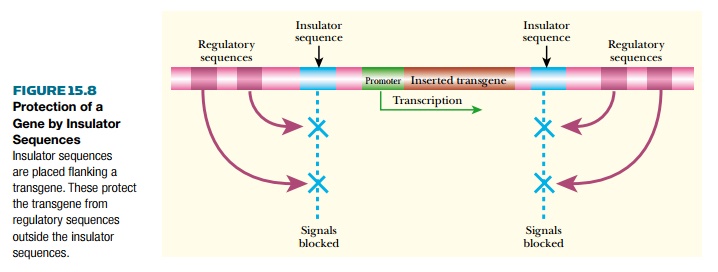Chapter: Biotechnology Applying the Genetic Revolution: Transgenic Animals
Combating Location Effects on Transgene Expression
COMBATING
LOCATION EFFECTS ON TRANSGENE EXPRESSION
Location effects may be
avoided by targeting the transgene to a specific site (see later discussion).
Alternatively, appropriate regulatory elements can be built in to the transgene
construct itself:

(a) Dominant control
elements. Some regulatory sequences control nearby genes or clusters of genes
in a dominant manner. For example, the locus control region (LCR) in front of
the β-globin gene cluster confers high expression (Fig. 15.7). Note that the
LCR is distinct from the individual promoters and affects several clustered
genes. LCR sequences dominate over any other nearby regulatory sequences and
thus provide position-independent expression. Such LCR sequences may be placed
in front of transgenes and, it is hoped, will confer high-level expression that
is independent of chromosomal location.
(b) Insulator sequences or boundary elements. These sequences block the activity of other regulatory elements. If a gene is flanked by two insulator sequences it is protected from the effects of any regulatory elements beyond the insulators (Fig. 15.8). Hence transgenes can be protected from position effects by including insulator sequences in the transgene construct. Transgenes flanked by insulators probably form independent loops of DNA from which heterochromatin is excluded.

(c) Use of natural transgenes. Most transgenes actually consist of cDNA
and therefore differ from the original wild-type version of the gene in lacking
introns. Furthermore, most transgenes are under control of viral or artificial
promoters, which are shorter and more convenient to engineer than the natural
promoters from the original gene. Nonetheless, full-length natural eukaryotic
genes are often more resistant to position effects than the shortened engineered
versions, especially if both upstream and downstream control elements are
included.
Cloning and manipulating
full-length animal genes is inconvenient because of the excessive lengths of
DNA involved. Nonetheless, it is possible to carry such genes on artificial chromosomes. In a few cases, natural length transgenes carried on yeast artificial chromosomes (YACs) have
been used to construct transgenic animals. YAC-based transgenes have been used in the study of long-range regulatory
elements. They have also been used to introduce into mice full-length genes for
humanized monoclonal antibodies.
Related Topics